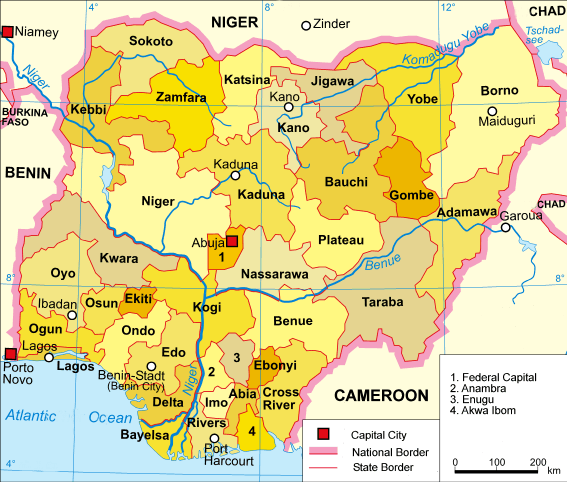States of Nigeria
 |
| This article is part of a series on the politics and government of Nigeria |
| Nigeria portal |
|
Politics portal |
Nigeria is divided into 36 states and the Federal Capital Territory, Nigeria. The states are further divided into 774 Local Government Areas.[1]
Current states and the Federal Capital Territory of Abuja
|
A clickable map of Nigeria exhibiting its 36 states and the federal capital territory.


| ||||||||||||
Former state boundaries
Before and after independence in 1960, Nigeria was a federation of three Regions: Northern, Western, and Eastern. Provinces were also used in colonial times. In 1963, two provinces were detached from the Western Region to form the new Mid-Western Region. In 1967, the regions were replaced by 12 states due to a military decree; only the former Mid-Western Region escaped division, and formed a single state following the restructuring. From 1967 to 1970 the areas of Mid-Western State and the Eastern Region attempted to secede, as Biafra. In 1976, seven new states were created, making 19 altogether.[2]
The Federal Capital Territory (now called Abuja) was established in 1991. In 1987 two new states were established, followed by another nine in 1991, bringing the total to 30.[2] The latest change, in 1996, resulted in the present number of 36 states.
1991-1996
During this period, there were 30 states and Abuja, the Federal Capital Territory.

1987-1991During this period, there were 21 states and,  |
|
1976-1987During this period, there were 19 states.  |
|
1967-1976During this period, there were 12 states.  |
1963-1967During this period, there were 4 regions.  |
|
1960-1963During this period, there were 3 regions.  |
|
Chronology
| Regions | States | ||||
|---|---|---|---|---|---|
| 1960 | 1967 | 1976 | 1987 | 1991 | 1996 |
| Eastern | South-Eastern | Cross-River | Akwa Ibom | ||
| Cross-River | |||||
| East Central | Imo | Abia | |||
| Imo | |||||
| Anambra | Anambra | ||||
| Enugu | Enugu | ||||
| Ebonyi (also includes part of old Abia) | |||||
| Rivers | Bayelsa | ||||
| Rivers | |||||
| Mid-Western (1963) | Mid-Western | Bendel | Delta | ||
| Edo | |||||
| Western | Lagos | ||||
| Western | Ogun | ||||
| Ondo | Ekiti | ||||
| Ondo | |||||
| Oyo | Osun | ||||
| Oyo | |||||
| Northern | Benue-Plateau | Benue | |||
| Plateau | Nasarawa | ||||
| Plateau | |||||
| Kano | Jigawa | ||||
| Kano | |||||
| Kwara | Kwara | ||||
| Kogi (also includes part of old Benue) | |||||
| North Central | Kaduna | Kaduna | |||
| Katsina | |||||
| North Western | Niger | ||||
| Sokoto | Kebbi | ||||
| Sokoto | Sokoto | ||||
| Zamfara | |||||
| North Eastern | Bauchi | Bauchi | |||
| Gombe | |||||
| Borno | Borno | ||||
| Yobe | |||||
| Gongola | Adamawa | ||||
| Taraba | |||||
See also
Notes
- ↑ "USAID Nigeria mission: Nigeria administrative divisions" United States Agency for International Development, October 2004, last accessed 21 April 2010
- ↑ 2.0 2.1 Kraxberger, Brennan (2005) "Strangers, Indigenes and Settlers: Contested Geographies of Citizenship in Nigeria" Space and Polity 9(1): pp. 9-27, pages 10, 11, & 15
Sources
- Ajayi, Gboyega (2007) The military and the Nigerian state, 1966-1993: a study of the strategies of political power control Africa World Press, Trenton New Jersey, ISBN 1-59221-568-8
- Benjamin, Solomon Akhere (1999) The 1996 state and local government reorganizations in Nigeria Nigerian Institute of Social and Economic Research, Ibadan, Nigeria, ISBN 978-181-238-9
- Suberu, Rotimi T. (1994) 1991 state and local government reorganizations in Nigeria Institute of African Studies, University of Ibadan, Ibadan, Nigeria, ISBN 978-2015-28-8
External links
- New States of Nigeria at statoids.com
- Headline News in Nigeria States
| ||||||||||
| ||||||||||